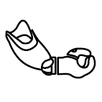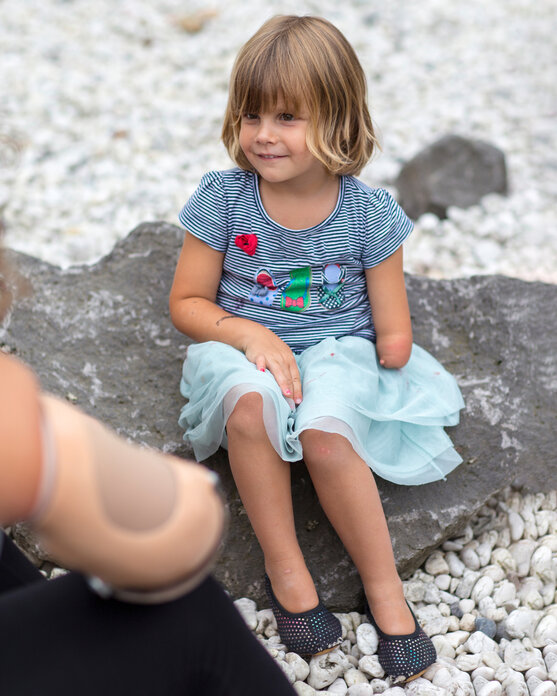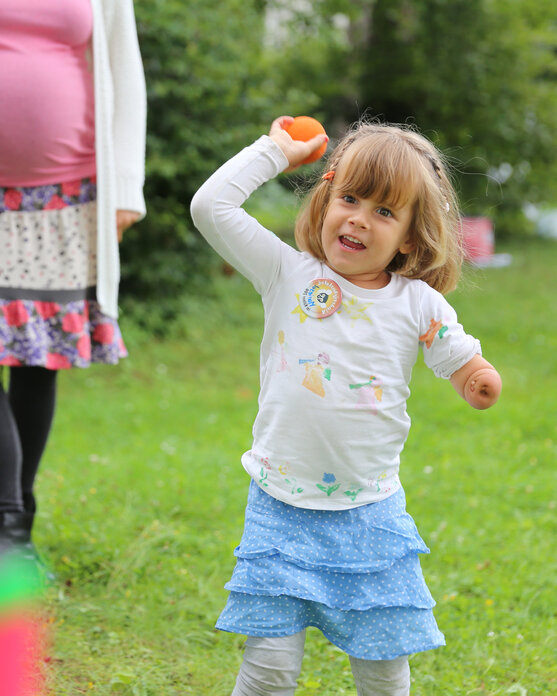
The FIRST prosthesis is an arm prosthesis for small children with various interchangeable attachments.
An individual hand or arm tool that makes it easier for you to perform a specific activity (e.g. eating, cycling, etc.).
Make an appointment over the phone or send us a message!
Born without a hand
My child has dysmelia – now what?
Dysmelia is a generic term for different deformities of one or more limbs, i.e. the legs or arms or feet, toes, hands or fingers. As dysmelias occurs during pregnancy, they are considered congenital deformities. The extent can vary greatly from child to child.
Parents who find out that their child is affected by dysmelia on their arm or hand have many questions: What restrictions will my child have? What can the child do with arm or hand deformity – and what not? How much will the malformation affect my child’s life?
These questions cannot be answered in a general manner, as each dysmelia is different. That’s why every child also needs an individual therapy and assistive device concept adapted to their everyday life and development status.
We would be happy to provide non-binding advice to affected parents and clarify the individual possibilities for functional improvement.

A random mood of nature?
Causes and symptoms of dysmelia

Science makes numerous assumptions about the causes of dysmelias. However, in around 60% of all cases, there is still no explanation for the occurrence of deformities on the hand or arm.
It is clear that dysmelia can be inherited or caused by a genetic defect. However, external influences are much more likely. For example, various viral infections cause hand and arm deformities in children. However, malnutrition in the mother during pregnancy or amniotic band syndrome (ABS) are also conceivable causes of dysmelia. ABS is the strangulation of already developed limbs, toes or fingers by fibrous amniotic ligaments (connective tissue strands) in the womb. The amniotic bands can cause anything from barely perceptible constrictions up to amputations. Compared to the dysmelia stump, which is smooth and round, amniotic stumps can be seen as ring indentations or notches. In addition to amniotic band syndrome, other factors such as certain medications, radiation or circulation disorders of the unborn child can cause arm or hand deformity.

Dysmelia patients often suffer from functional limitations of deformed hands or arms, which can vary in magnitude.
Possible consequences are, in particular, misaligned postures:
- inner or outer rotation misalignment in the upper arm,
- high shoulder blade height compared to the opposite side,
- overstretchability in the elbow joint,
- hypermobility in existing finger buds and adjacent joints
Keeping an overview
Forms of dysmelia
Deformities of the extremities are generally divided into two groups:
- Transversal deformities combine all “amputation-like” states with a stump that is usually regularly shaped. In the transverse plane (i.e. horizontal to the longitudinal axis of the body), parts of the extremities do not develop at all or are corded off.
- Longitudinal malformations: In this case, certain vertical rays are absent or underdeveloped (limb inferiority). In the region of an upper extremity, for example, the hand or ulna and radius bone develop only partially (or shortened), but may be completely missing – as with the radial club hand.
Within these two groups, there are numerous characteristics of different dysmelias. Science classifies them in different ways. The following overview is based on the four categories defined by Ilse Martin:
Transverse malformations:
1. Amelie: complete absence of one or more extremities. Missing all four limbs is called tetra-amelia.
2. Peromelia: truncation of an upper limb into a stump. The stump is amputation-like and regularly shaped. Peromelia generally occurs on one side only, without any further concomitant malformations.
Longitudinal malformations:
3. Phocomelia: severe underdevelopment or absence of one or more limbs. The hand connects directly to the shoulder, the foot to the hip.
4. Ectromelia: collective term for hypoplasia (underdevelopment) and aplasia (absence of certain parts of the body) of individual or several long bones. Shortening of long bones or lack of a bone partner of double-bone extremities. In the area of the upper extremities, the ectromelia includes deformities of the forearm bones and the hands. These include, for example, the cleft hand (wedge-shaped defect of the central rays of the hand), the radial and the ulnar club hand, as well as the underdevelopment or absence of fingers in connection with deformities of the double-bone arms.
The following overview provides another way of differentiating between them:
A) Missing body parts (aplasia)
Examples:
- Hemimelia: amputation-like, partial or complete absence of a part of the limb
- Ectrodactyly: Missing finger
- Thumb aplasia: Thumb missing or reformed
B) Body parts grow together
Examples:
- Syndactyly: adhesion of adjacent fingers
- Symbrachydactyly: adhesion of adjacent fingers with additional short fingers
C) Congenital duplication (Polymelia)
Example:
- Polydactyly: formation of additional fingers
D) Over- or underdevelopment
Examples:
- Brachydactyly: shortening of fingers or underdevelopment
- Thumb hypoplasia: underdevelopment of the thumb ray
- Mesomelia: shortening of the forearm
- Rhizomelia: shortening of the upper arm
- Gigantism: overdevelopment of a bone
- Hypertrophy: enlargement of bones and fatty tissue
- Macrodactyly: enlargement or overdevelopment of fingers
Which therapy is right for my child?
Treatment options
Apart from the fact that the external appearance of the arm or hand differs from the average of the population, the children affected are usually healthy. There are functional differences compared to children with healthy extremities, of course, but these can be offset early on in childhood by learning compensation mechanisms. Children with dysmelia often develop amazing dexterity and sensitivity when handling their misshapen hands or arms. Nonetheless, early treatment should be sought so that the infant can go through the necessary developmental steps from birth and gain a wide range of movement experiences.
First, the therapy goal must be defined. The top priority should always be to ensure that the child is as independent as possible – whether at home or on the go. The therapeutic options of dysmelia are broad and must be individually adapted to the everyday life and development status of the child.

The following treatment options are available:
In addition to cosmetic aspects, prostheses and everyday aids can also offer functional advantages for patients with dysmelia. It is important to note that the device actually encourages – not restricts – the child’s activity.
In addition to grasping aids that serve as a kind of tool for the child and simple, passive arm prostheses, more complex models (myoelectrically controlled treatments) can also be used, even by small children. These arm prostheses enable bilateral handling (both sides).
Taking into account the degree of severity and the special features, the therapeutic procedure is adapted to the respective hand or arm deformity. The occupational therapy prescribed by the doctor is primarily to help patients practice all of their everyday abilities. Physiotherapy provides better mobility. Special exercises can be used to build up muscles and endurance.
Furthermore, occupational or physiotherapists support the child in the testing of aids, adaptations or rails. They help the child to integrate the prosthesis into their body schema and, in some cases, also to incorporate it into the gesture.
If the grasping function is not present due to dysmelia and both hands may be affected, an operation to improve mobility may be considered. Examples of this are stump-elongating measures, operative splits of spoon hands or toe transfers. The procedure is performed by specialized hand surgeons. The age at which an operation is performed depends on the characteristics of the dysmelia.

Prostheses and everyday aids
Unlike amputees, children born with dysmelia initially lack nothing in their body picture. With their two differently formed hands, they still feel like an complete person with an intact body structure. No stump or phantom pain occurs. Like any healthy hand, the deformed extremity has complete sensitivity.
Children with dysmelia therefore usually have a different view of assistive devices than amputees do. For dysmelia patients, prosthetics or everyday aids are not fundamentally a replacement, but primarily a situational tool for achieving certain goals.
The great advantage of a prosthesis or everyday aids is that the aid can reduce or avoid overloading and wear and tear caused by overloading the opposite side. In addition, prostheses and functional aids, such as eating, writing, sporting or musician aids, can open up completely new possibilities for the child. Because the exercise of these newly acquired skills also trains the brain, such aids can also positively contribute to the cognitive development of the child.
We have been treating children with malformed hands or arms very successfully for decades. Our prosthetics experts use their unique experience and know-how to provide every child with the equipment that is precisely tailored to their individual needs and requirements.
What sets treatment with an assistive device at POHLIG apart?
- Clear objective: With our assistive devices, we aim to enable dysmelia patients to live as independently as possible.
- The focus is on the child: The patient and their functional impairment are our top priorities. Before orthopedic technical measures are implemented, there must be a prospect of concrete functional improvement (functional gain). If the device is intended to be used for aesthetic correction, the arm function must not suffer under any circumstances.
- Collaboration in interdisciplinary teams: A prosthesis or everyday aid only makes sense if the child recognizes an advantage for their daily life. We rely on close cooperation with therapists, doctors, parents and young patients in order to integrate a device into the child’s everyday life.
- Individual training: Training in the day-to-day use of the prosthesis or everyday aid is an integral part of treatment with assistive devices at POHLIG. Our physiotherapists specifically address the needs of the respective child and playfully practice with them how the aid can be used sensibly. Young patients can get to know other children with dysmelia and discover the possibilities of their prosthesis at regular MyoCamps.


Let yourself be inspired! We accompany many interesting patients during their Pohlig appointment and give you personal insights.

For those who want to delve even deeper into the matter, we have a suitable video for almost every supply area.

Take a look behind the scenes at Pohlig and find out about diagnoses and our innovative aid solutions!

